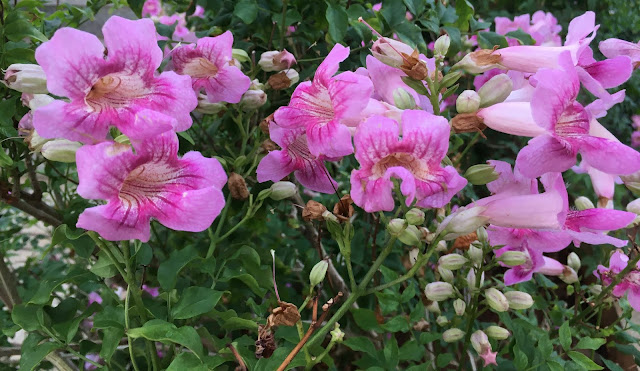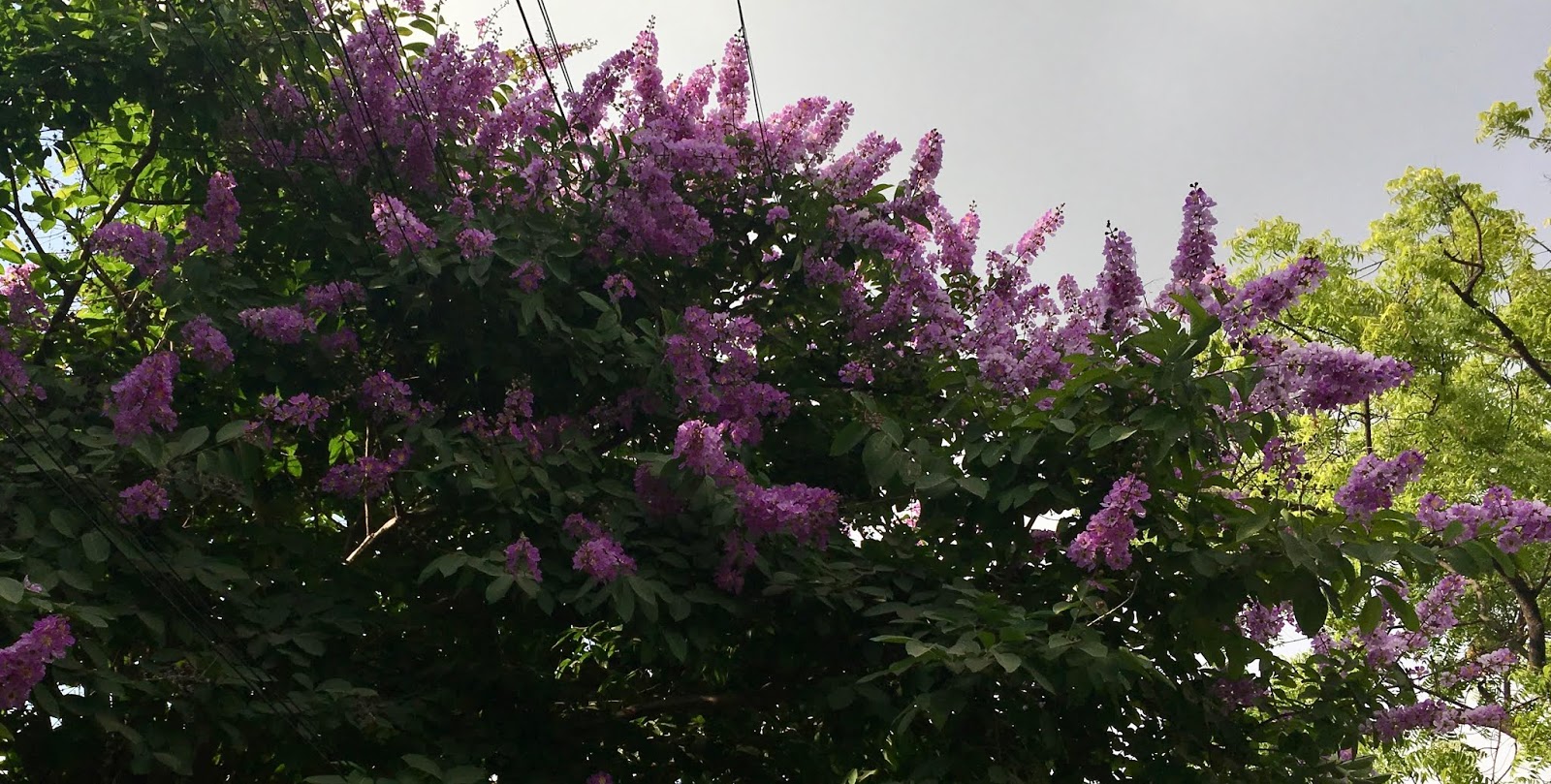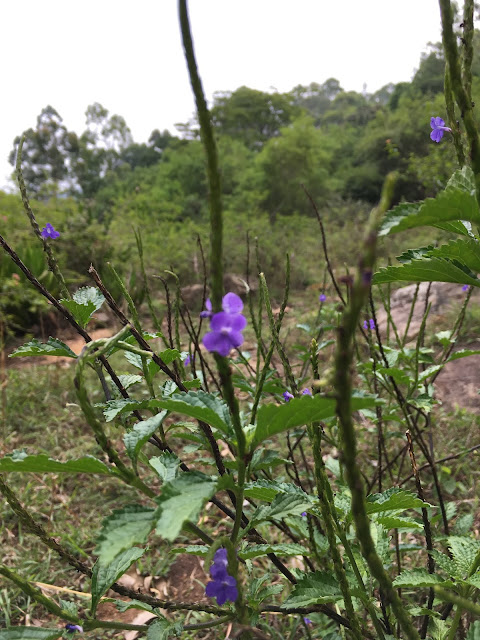I came across this beautiful essay in the Madras Naturalists' Society, MNS Blackbuck monthly bulletin, and what a beautiful piece of writing it was for me. I wanted to re-read and store it for easy access, and to share the joy of reading this with more people.
The Palaash is a glorious glorious tree, sadly infrequent in my life and Starlings come and go with the season, adding that excitement to the magic of migration.
Palaash Blossoms and Rosy Starlings - by Yuvan Aves
 |
| "From a distance, with some imagination on my part, the tree could well be a titan’s arm reaching up with his palm spread wide, his crooked fingers dripping with magma, having broken through the crust." Butea monosperma (Palaash) Photo by Yuvan |
If not every day, then during every transiting month, the human being who pleasures in taking long walks and communing with the landscape, has something or the other to anticipate excitedly.
March is almost upon us and the Palaash trees everywhere are full of buds, making their branches sag. Very soon, when one looks up one morning, they would have suddenly bloomed altogether, overnight. And the tree would then bear not a sole leaf. Not a tinge of dark green would be seen on its crown, for it would have replaced every single one of them with its tongue like kesari-orange flowers curling towards the sky. From a distance, with some imagination on my part, the tree could well be a titan’s arm reaching up with his palm spread wide, his crooked fingers dripping with magma, having broken through the crust. The roads and walkways below are carpeted. The canopies of the smaller trees around are topped. Its flowers bob all along the shores of a pond or lake, if one is nearby. A tall flowering Palaash is a salient landmark wherever it is.
For a few years I was blessed with the opportunity of walking every morning by a very old Palaash tree, down the road from the campus I taught in. It stood on the bund slope of a village lake. Much of the wood in its ancient rugged trunk had been carved out by insects and the weather, and for much of its height, only a thin rim held up its branches and foliage. How was it managing to convey life to its broad-spread crown? In its shade and across the road were dozens of Palaash saplings of various heights. Some were even young trees at a blooming age, and all were its children. For a portion of the road I had gotten used to the familiar rustle of the flat, wide, brittle leaves of these Palaashes. It wasn’t like the thick gurgling of a Neem tree nor was it like the torrential sound of a Banyan. The sound of the Palaash was like a crowd of paper hands applauding.
Reading Peter Wohlleben and about the Wood wide web, I now think I understand the life of this mother Palaash better. I can imagine its wide roots beneath the road entwined with those of all its children. Maybe many years ago it nourished them, sending down all the surplus nutrition it made in its leaves. Now as it ages and its trunk withers from inside, surely it is in its offspring’s care, which are holding to it and supplying what it needs to keep alive.
Intelligence can extend across larger forms, beyond close fitting skulls, beyond bodies and entities. The Earth, Gaia, has its own inherent intelligence as Lovelock testifies, just as did many ancient cultures much before. And this is not the sum of all its beings and matter. It is a sentient creature by itself. A star cluster may have its own larger intelligence. And a flock of birds have a complex intelligence, unconfined by feathers, flesh and space. How then does one explain starlings and the shapes of their murmurations? Hundreds of birds spiraling and snaking in the sky, a cloud of black masses clustering, stretching, folding and evolving in abstract ways. I have seen a whale, a hook, a boomerang and some other vague resemblances which my mind strives to identify with something of its own world.
How then does one explain a whole flock, dispersed across an overgrown pasture, spontaneously taking off together? How also does one explain the settling of the entire flock, all together in the afternoon on a flowering Palaash, or at dusk, on the same leafless tree, as if all were of one mind? I like the way Robert Macfarlane words this in a poem in The Lost Words - “Ghostly swirling surging whirling melting murmuration of starling flock.”
I speak of Rosy Starlings, the second most common starling I am accustomed to seeing but I might as well be speaking about European starlings or the White-Winged Black-Terns I see sometimes behaving similarly above the wetlands they come to.
 |
| Pastor roseus, Rosy Starling on the Palaash - Photo by Yuvan |
Rosy Starlings are late migrants into the southern reaches of the country and it is only by mid or late December that I first see little troops of them trickling in. Having not seen them for more than half the year, I always end up wondering what on Earth those birds were which shot over me, when the first arrive. Here during this time in Kanchipuram and much of rural Tamil Nadu, some of the farmers would have ploughed their fields and sowed the Navarai crop (the paddy to be harvested in Summer). But much of the land in dry and semi dry areas is fallow, overgrown with Ban Tulsi, Tephrosia, countless grasses and little shrubs. These untilled fields are where you will find the starlings for most of the day.
The flocks will descend steeply from above, swerve parallelly to the ground and in a flicker, would have abruptly vanished into the low vegetation. A second ago there would have been a crowd of nosediving shapes striving to retard their momenta, seemingly a moment too late, and in the moment after, they would have all submerged into the shrubbery as if it were water, with no thuds or squeals. The plants don’t twitch with their activity. I imagine them moving on mute feet, carefully stalking insects hiding by the stems and in the soil cracks. Here and there a starling would jump above the vegetation and land back in. And then one can tell that they are running behind and trying to catch the insects they have flushed. When they decide to, they would all take off in a single explosion.
Rachel Carson calls it the ‘Other Road’, like a lamp of hope at the very end of deeply disquieting and illumining ‘Silent Spring’. In essence, she speaks in this chapter about using wisdom from nature for our means to grow, to feed and to live as opposed to butting heads with the ingenuity of something as old as time, whether it be flooding our food crops with poisons or be it among the countless other practices our contemporary ways of life demand, which has made every stratum of the biosphere less fit for life.
And while writing of Rosy Starlings one also definitely needs to narate the story of the Xinjiang. This is an agricultural district in China where these Starlings naturally bred every Summer. The croplands here were perpetually under the scourge of Locusts and Grasshoppers, and these phytophagous insects seemed to quickly develop a facile resistance to the expensive quantities of insecticides used on them. It took one sharp observation by a local to discover that Rosy Starlings primarily fed on these very insects as they foraged the fields. The farmers setup artificial nests around their farms to invite the birds to breed nearby and it is reported that in a few years the locust populations fell so low that insecticide use was practically stopped. This success story could underline the importance today of working with nature, aligning one’s efforts along its own principles versus, attempting to subdue it.
These Starlings also visit the flowers of the Silk Cotton and the Coral tree. Maybe sometimes forage the Babuls and Subabuls (certainly not for nectar). But from what I have seen, the nectar of Palaash blossoms are their single most favourite. The tree is visited also by many other nectar feeders. I would sometimes see Flowerpeckers on it which would have travelled from the nearby hills. One wouldn’t see these tiny tots anywhere near here during the rest of the year. The collective sounds of the starlings emanating from the crown would be like a noisy gurgling stream collapsing on the rocks, drowning out the cackling of the Treepies, the Sunbirds, Barbets, the bawling of the Common Mynahs and also the Bullock carts and Motorcycles passing below. Conversations would briefly pause when we went by this Palaash tree during morning walks. The birds are like a dining hall full of children at lunch break.
By April the red flowers would have started turning into flat pods and the Rosy starling flocks would have also turned homewards. Yet an old tree, still flowering each year, with its rugged weather worn trunk holds this fragile kinship, a bond between a population of migrating birds and a remote village in the Southern reaches of the country.
Trees have personalities. Some trees behave differently when alone and when in a group of their own company. Mango growers have told me this. Mango trees planted alone succumb more quickly to beetle and fungal attacks than one growing in an orchard. A Banyan on the other hand likes to be a loner and is likely to not let another grow too closeby. Their aerial roots can attach to other trunks, parasitize them and finish them off over time. Quite often an infant Banyan reaches adolescence by choking a Palmyra tree, a very common choice of host given that its trunk is full of crevices, and over many years swallowing it into its trunk and replacing it. A Palaash is a sought after tree for its flowers. Schools and institutions take home a single sapling to plant in their courtyard. I have come across so many such lone standing trees within paved perimeters which look sickly and which refuse to flower. Or at the most flower reluctantly once in many years. But do witness for yourself in the places where generations of these trees are allowed to grow together as close neighbors. The mature trees blossom punctually year after year.
At a facile level, yes, it is necessary to protect an old tree such as this Palaash, which probably has been by this lake as long as the village has been. It would have seen generations and generations of starlings and other birds feeding from its flowers, chicks growing into adults and flying back with their offspring. Billions of bees, other insects and their larvae would have drawn sustenance from it over the decades. Its flowers would have decorated and sanctified altars and the temples nearby. Its presence would have lent itself, in some subtle or small way, to all those who travelled beneath it. But at a deeper level, an ancient tree offers something else to everything around which is more difficult to put in words. I have found myself at times segue into a conversation or speaking aloud to the Palaash while sitting beneath it alone. A tree can be a patient and non-judging listener, a counsellor even. I have felt healed and discernably more at peace with myself. Sometimes I have stood by it for a long time touching my palm to its craggy trunk and just imbibing the feeling of it. One could say that trees have an energy field around them, as Eckhart Tolle may wish to put it. A field where living organisms thrive but also where one palpably feels thought or any kind of human conflict to be diminished. A pervasive and penetrating space of intrinsic harmony. And if one comes to rest beneath its trunk with stillness one is certainly touched by this dimension. After a while one may walk away with a burst of clarity.




























































